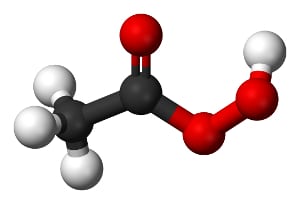
How It’s Used
Peracetic acid—also known as Peroxyacetic acid and often abbreviated as PAA—is a highly effective antimicrobial, used in a wide range of applications, primarily in the food industry and health care settings. PAA disinfects by oxidizing the outer cell membrane of bacterial cells, endospores, yeast, and mold spores. The commercial product is an equilibrium solution of peracetic acid, hydrogen peroxide, acetic acid, and water.
It is also employed as a bleaching agent in the paper and textile industries, and in chemical synthesis. In certain settings, PAA has been replacing chlorine and chlorine dioxide, owing to its higher oxidation potential, as well as its non-toxic degradation products–ultimately carbon dioxide, oxygen, and water. Indeed, PAA is widely used in Europe for wastewater disinfection.
In the realm of health care, even though the anti-bacterial properties of PAA had been known since the early 1900s, the chemical gained two major boosts in popularity over the last 50-odd years. In January 1960, a breakthrough paper1 was published describing the use of PAA as an antiviral agent. This was followed in the 1990s by the emergence of endoscopic procedures, along with the continuing interest in finding an alternative to glutaraldehyde, as the high-level disinfectant of choice. An entire industry of so-called automated endoscope reprocessors would emerge, many of which are based on peracetic acid disinfectants.
Occupational Health/Toxicology
Full record from Hazardous Substances Data Bank (HSDB), a database provided by the US National Library of Medicine.
A health hazard evaluation report from the CDC entitled “Evaluation of Worker Exposures to Peracetic Acid-Based Sterilant during Endoscope Reprocessing.” [pdf file—3.7 MB]
On January 31, 2014, The American Conference of Governmental Industrial Hygienists (ACGIH) announced that its Board of Directors ratified the 2014 Threshold Limit Values (TLVs®) for Chemical Substances and Physical Agents and Biological Exposure Indices. Included among these chemicals is peracetic acid.
A new short-term exposure limit (STEL)—and only a STEL, not an 8-hour time weighted average (TWA)—for peracetic acid has been set at 0.4 ppm.
STEL = Threshold Limit Value—Short-Term Exposure Limit (TLV–STEL). A 15-minute TWA exposure that should not be exceeded at any time during a workday, even if the 8-hour TWA is within the TLV–TWA. The TLV–STEL is the concentration to which it is believed that workers can be exposed continuously for a short period of time without suffering from 1) irritation, 2) chronic or irreversible tissue damage, 3) dose-rate-dependent toxic effects, or 4) narcosis of sufficient degree to increase the likelihood of accidental injury, impaired self-rescue, or materially reduced work efficiency.
The TLV–STEL will not necessarily protect against these effects if the daily TLV–TWA is exceeded. The TLV–STEL usually supplements the TLV–TWA where there are recognized acute effects from a substance whose toxic effects are primarily of a chronic nature; however, the TLV–STEL may be a separate, independent exposure guideline. Exposures above the TLV–TWA up to the TLV–STEL should be less than 15 minutes, should occur less than four times per day, and there should be at least 60 minutes between successive exposures in this range. An averaging period other than 15 minutes may be recommended when this is warranted by observed biological effects. (definition per ACGIH)
While ACGIH TLVs have no legal authority per se, they are widely respected, and are often emulated in eventual regulations.
Monitoring Instrumentation
Check out Interscan’s full line of peracetic acid gas detection/gas monitoring instrumentation.
- Kline LB, Hull, RN. The virucidal properties of peracetic acid. Am J Clin Pathol. 1960;33:30–33. [↩]
